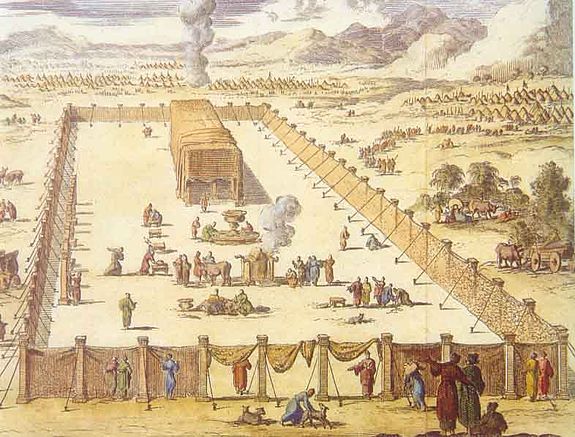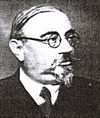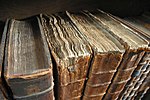Tetzaveh
[3] In the first reading, God instructed the Israelites to bring Moses clear olive oil, so that Aaron and his descendants as High Priest could kindle lamps regularly in the Tabernacle.
[4] God instructed Moses to make sacral vestments for Aaron: a breastpiece (חֹשֶׁן, Ḥoshen), the Ephod (אֵפוֹד), a robe, a gold frontlet inscribed "holy to the Lord," a fringed tunic, a headdress, a sash, and linen breeches.
[8] God instructed Moses to place pomegranates and gold bells around the robe's hem, to make a sound when the High Priest entered and exited the sanctuary, so that he would not die.
And then in Leviticus 14:17, God instructed the priest to put oil on the tip of the right ear, the thumb of the right hand, and the great toe of the right foot of the one to be cleansed, on top of the blood of the guilt-offering.
The parashah is discussed in these early nonrabbinic sources:[34] Ben Sira wrote of the splendor of the High Priest's garments in Exodus 28, saying “How glorious he was .
He interpreted the golden bells and pomegranates that Exodus 28:33–35 says hung on the fringes of the High Priest's garments to signify thunder and lightning, respectively.
[38] Philo taught that the command of Exodus 29:20 to apply ram's blood to the priests' right ear, right thumb, and right great toe signified that the perfect person must be pure in every word, every action, and the entirety of life.
And since each of these is an extremity of the right side of the body, Philo imagined that Exodus 29:20 teaches that one should labor to attain improvement in everything with dexterity and felicity, as an archer aims at a target.
[39] The parashah is discussed in these rabbinic sources from the era of the Mishnah and the Talmud:[40] A midrash taught that God considers studying the sanctuary’s structure as equivalent to rebuilding it.
[51] Similarly, Rami bar Hama deduced from the use of word לְהַעֲלֹת, lehaalot, in Exodus 27:20 that the Menorah flame had to ascend by itself, and not through other means (such as adjustment by the priests).
[52] The Gemara challenged Rami bar Hama, however, citing a Mishnah[53] that taught that the worn-out breeches and girdles of priests were torn and used to kindle the lights for the celebration of the Water-Drawing.
The Gemara countered with the teaching of Rabbah bar Masnah, who taught that worn-out priestly garments were torn and made into wicks for the Temple.
[60] Interpreting God's command in Exodus 28:1, the Sages told that when Moses came down from Mount Sinai, he saw Aaron beating the Golden Calf into shape with a hammer.
[63] The Babylonian Talmud related a story of how the description of the High Priest's garments in Exodus 28:4 led a non-Jew to convert to Judaism.
[64] Rav Naḥman in the name of Rabbi Mana noted that the words of Exodus 28:5, "They shall receive gold, blue, and purple and scarlet stuff, and fine twined linen," refer to the recipients in the plural (implying no fewer than two), and reasoned that the verse thus supported the Mishnah's injunction[65] not to appoint fewer than two people to a public position of supervision in property matters.
[68] Similarly, citing Mishnah Yoma,[62] Rabbi Simon explained that the priests' tunic atoned for those who wore a mixture of wool and linen (שַׁעַטְנֵז, shaatnez, prohibited by Deuteronomy 22:11), as Genesis 37:3 says, "And he made him a coat (tunic) of many colors" (and the Jerusalem Talmud explained that Joseph's coat was similar to one made of the forbidden mixture).
Rav Aha bar Jacob objected that perhaps Exodus 28:28 meant merely to instruct the Israelites to fasten the breastplate securely so that it would "not be loosed."
"[72] The Mishnah taught that the High Priest inquired of the Urim and Thummim noted in Exodus 28:30 only for the king, for the court, or for one whom the community needed.
Rav Aha bar Jacob objected that perhaps Exodus 28:32 meant to instruct that the Israelites make a hem so that the garment would not tear.
The midrash deduced that when in Numbers 11:1, the people murmured, speaking evil, and God sent fire to devour part of the camp, all those earlier 70 elders had been burned up.
The midrash continued that the earlier 70 elders were consumed like Nadab and Abihu, because they too acted frivolously when (as reported in Exodus 24:11) they beheld God and inappropriately ate and drank.
[89] The Sages interpreted the words of Exodus 29:27, "which is waved, and which is heaved up," to teach that the priest moved an offering forward and backward, upward and downward.
The Gemara explained that according to Rabbi Jose's reading, the words of Exodus 27:18, "And the height five cubits," meant from the upper edge of the altar to the top of the hangings.
Naḥmanides taught that the ephod and the breastplate were also royal garments, and the plate that the High Priest wore around the forehead was like a monarch's crown.
Finally, Naḥmanides noted that the High Priest's garments were made of (in the words of Exodus 28:5) "gold," "blue-purple," and "red-purple," which were all symbolic of royalty.
Similarly, Maimonides taught, God instituted many laws as temporary measures, as it would have been impossible for the Israelites suddenly to discontinue everything to which they had become accustomed.
But in the Divine plan, prayer and supplication can be offered everywhere and by every person, as can be the wearing of tzitzit (Numbers 15:38) and tefillin (Exodus 13:9, 16) and similar kinds of service.
Plaut concluded, however, that while the text likely contains embellishments from later times, there is little reason to doubt that it also reports traditions going back to Israel's earliest days.
[108] Plaut reported that the priestly garments enumerated in Exodus 28:2–43 are the direct antecedents of those used today in the Catholic and Greek Orthodox Churches, whose priests—and especially bishops—wear similar robes when officiating.
[111] Everett Fox noted that “glory” (כְּבוֹד, kevod) and “stubbornness” (כָּבֵד לֵב, kaved lev) are leading words throughout the book of Exodus that give it a sense of unity.














































